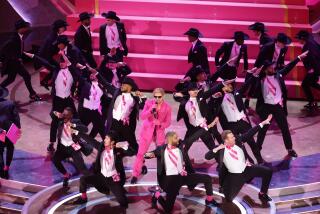Barbie’s boy toy Ken is working on a comeback
Ken Carson, always something of a stiff, is loosening up.
On the eve of its 50th birthday, the doll that defined boyish American urbanity is working on a comeback, proclaiming on billboards in Los Angeles and New York his love for Barbie. Critics raved about his appearance in “Toy Story 3.” And in a new reality TV show, “Genuine Ken: The Search for the Great American Boyfriend,” eight clean-cut real-life contestants vie to be judged worthy of Barbie: a guy with style who knows how to listen, cook, surf and spoil the material girl with displays of affection.
Mattel Inc.’s push to make Ken cool, particularly among adults, is part of a broader campaign to crank up sales of the doll as it hits the big 5-0, as the company did successfully when Barbie passed the half-century milestone two years ago. Mattel executives say they are relaxing their tight control over Barbie’s and Ken’s images because they missed marketing opportunities in the past by letting Ken — introduced to the world in March 1961 in red swim trunks, sandals and a yellow terry-cloth towel — turn into, well, a square.
“What we realized a few years ago was, ‘Wait a second, there are people having more fun with the brand than we were,’” Stephanie Cota, Mattel’s senior vice president of global marketing for girls brands, said in an interview. “Part of the journey that we’ve been on is figuring out how to have fun with the Barbie brand without making fun [of it].”
It’s a delicate balance. Too much self-mockery could be interpreted as a signal that Mattel isn’t serious about the brand. Walt Disney Co.’s Pixar Animation Studios took a poke at Ken in its Oscar-nominated “Toy Story 3,” where the doll shows up wearing short shorts, an open shirt and a blue ascot while tooling around in a pink convertible, seemingly oblivious to his main purpose to serve as arm candy for Barbie.
Some saw Ken’s love of fashion and his gold-and-purple “dream house” in “Toy Story 3” as a sly wink at longtime rumors of a conflicted sexuality, and an example of how the brand can appeal to multiple markets.
Barbie has long been the alpha female. Sean McGowan, a toy analyst with Needham & Co., estimated that Ken makes up less than 10% of the Barbie line’s sales. He said Ken’s appearance in “Toy Story 3” could have backfired.
“Ken stole the show ‘cause he’s a clothes magnet,” McGowan said. “That’s risky, but it worked. He winds up looking cool. [But] that’s a fine line between parody and pushing the envelope.”
Barbie, meanwhile, has been enjoying resurgence after a period of turmoil and slumping sales. About a decade ago, Mattel watched as its premier toy brand was swiftly eclipsed by MGA Entertainment Inc.’s newcomer Bratz, a line of sultry, pouty-lipped multi-ethnic dolls whose street style made Barbie seem stuck in the past.
The Barbie line, which in the late 1990s commanded as much as 85% of the fashion doll market, tumbled to about 60%, according to BMO Capital Markets toy analyst Gerrick Johnson.
Keeping Barbie and Ken in sync with the times has long presented challenges, and today’s fashion doll category is more crowded than ever. Barbie (full name Barbara Millicent Roberts) has been trying to defend her shelf space against such lines as Liv, Bratz, Disney Princess, Wizards of Waverly Place, Moxie Girlz, BFC Ink and iCarly — and even Monster High dolls, also made by Mattel.
Well off their peak, Barbie sales, which include the Ken line, now account for about $1.2 billion annually at the wholesale level, analysts estimate. Mattel says Barbie is a $3-billion brand.
Last week, the El Segundo toy maker said its 2010 revenue increased 8% from the year before, largely because of strong sales of Barbie and related products. Barbie has displayed renewed strength, pulling market share away from her rivals thanks to the success of newer products aimed at slightly older girls.
“Mattel has kind of turned a corner. They are doing a lot of cool and innovative stuff,” Johnson said. “They were wandering in the wilderness for a while. Barbie looked dowdy, shall we say; just missed the mark on fashion and became somewhat irrelevant.”
Mattel’s marketing efforts are slated to reach a crescendo Monday, Valentine’s Day, when Barbie decides whether to take back Ken. According to Barbie lore, she called it quits on their relationship back in 2004, feeling that after 43 years, she needed time apart.
By producing a reality show a la “The Bachelor” and launching Facebook and Twitter accounts for Barbie and Ken, Mattel is targeting an older cohort than its core preschool and grade-school crowd.
The “Genuine Ken” reality series, which debuted last month on the online video website Hulu, was designed to appeal to 18-to-34-year-old women who fondly remember playing with their own Barbie and Ken dolls but who now watch the latest reality show vixens and villains for entertainment.
Hosted by MTV star Whitney Port, whose long blond hair and willowy figure echo classic Barbie traits, the series has been among the most popular reality shows on Hulu.
Shot primarily in Los Angeles, the series puts eight “Ken-testants” through their paces with such challenges as decorating an apartment on a budget and cooking a meal, and avoids the acid pettiness and raunch often laced throughout reality shows.
Here, wholesomeness is represented as part of the contestants’ sex appeal.
“We stayed away from things that were overtly sexual. We stayed away from alcohol, from some of the things you might see in other reality programming,” Cota said.
Still, “Genuine Ken” isn’t going to land on kids’ TV.
In one episode, the visuals shift into slow motion when the contestants jog to the beach and later rip off their shirts; the show zooms in on their well-sculpted abs. When one contestant strips naked to don a wetsuit, a turquoise “Ken” name tag appears onscreen to cover his anatomy.
“There is a fun, celebratory and campy nature to the show,” said producer Michael Rourke, chief executive of Hudsun Media, which approached Mattel with the concept. Mattel immediately got on board, Rourke said.
“They were in complete agreement in the spirit in which we approached the project: It was about having fun with this great icon while also exploring what it takes to be a great boyfriend.”
The winner will be given the title “Genuine Ken: The Great American Boyfriend,” and Mattel will produce a Ken doll in his likeness. The show was just one aspect of Mattel’s makeover of the doll named after the late Ken Handler, the son of Mattel founders Ruth and Elliot Handler.
“Will ‘Genuine Ken’ have a direct effect at retail? Probably not,” Cota said. “But will ‘Genuine Ken’ continue to help keep this brand relevant or leapfrog us into the next level of relevancy? Absolutely. We can’t drive sales if we don’t have a product and brand property that is relevant, modern, fresh and contemporary.”







